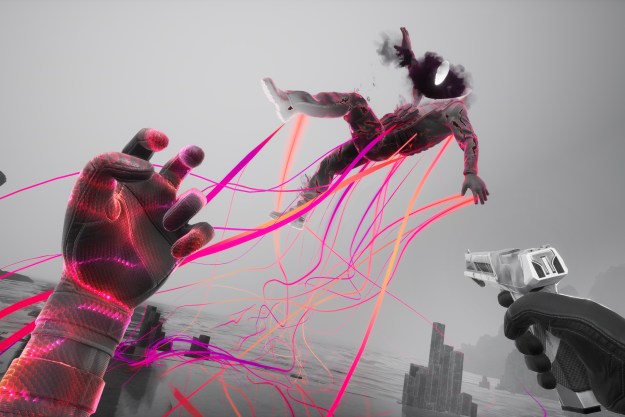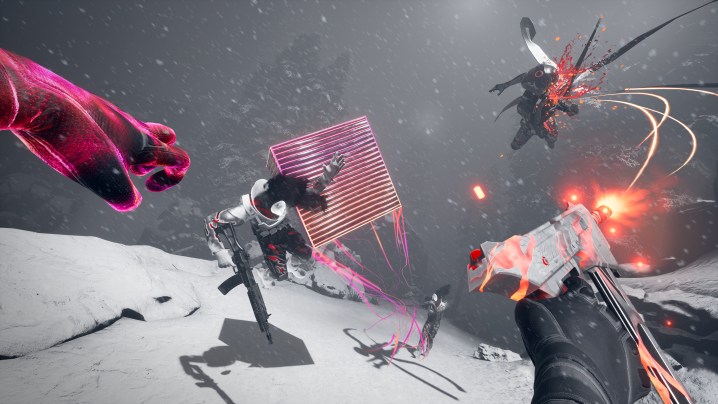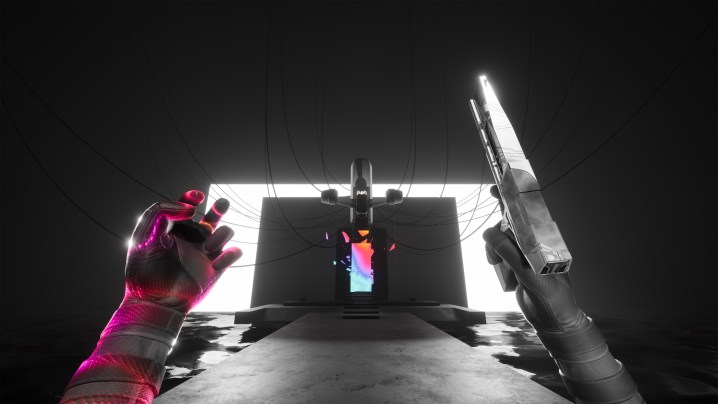
“Synapse is a flashy PlayStation VR2 exclusive roguelite that gets too repetitive for its own good.”
- Stunning visuals
- Telekinetic powers
- Intriguing story
- Lack of content variety
- Linear roguelite structure
I’ve never reviewed a game in VR before, so Synapse was a pretty mind-bending experience. I had to critically assess it while totally immersed in a virtual space, not just while playing and looking at it on a flat screen. It was unfamiliar but exciting review territory that had me adapting my critical skills in a different setting while facing the unknown. And in some ways, that actually brought me closer to Synapse‘s protagonist, who dives into the mind of a rogue agent and must fight his way out.
That’s all tied up in a political espionage sci-fi thriller inspired by the likes of Inception and Metal Gear (developer nDreams even got Solid Snake actor David Hayter to voice one of the characters) and structured as a roguelite. Synapse makes a great first impression as a visually stunning and fun VR first-person shooter, the kind of exclusive the PlayStation VR2 desperately needs more of going forward. Within the mind of a rogue agent, I’d fight lots of mind contract enemies with a variety of weapons and exhilarating powers across starkly designed black-and-white levels, getting a bit more powerful after each level with mind hack abilities and a little more powerful after each run with Insight upgrades.
The more I played, though, the more the cracks and flaws in Synapse’s roguelite design started to show, as it never strays far enough away from its core hooks. Reviewing a game in VR for the first time, I had to recontextualize the skills I’ve learned while engaging with console games; unfortunately, nDreams wasn’t quite able to do the same when mapping its strong VR shooter design philosophies to a roguelite.
Don’t mind me
Synapse put me into the body of a secret agent working for an organization called Bureau V and dropped me off on a remote island to take out Colonel Peter Conrad. Conrad is a former bureau agent who defected and is supposedly planning a terrorist attack, and the only way for me to find out where the attack is taking place is by delving into Conrad’s mind, which is where a majority of Synapse takes place. At first, the game tells players very little about the outside world, but the stakes and tension still felt very palpable as I existed within this universe in VR.
Things quickly got otherworldly once I dove into Conrad’s mind. Color was drained out of the world, and everything became black and white, making it clear that I was exploring the dark recesses of Conrad’s mind and was not wanted there. This aesthetic gives Synapse a gorgeous and immediately recognizable visual identity and a AAA feel that I wish we’d already seen more of from the PlayStation VR2. It’s not entirely devoid of color, though, as some bright blues, pinks, and purples are tied to the primary gameplay power of Synapse: telekinesis.

Synapse gives me plenty of weapons to toy around with in VR, from pistols to shotguns, to a grenade launcher. These kill the mental construct enemies just fine, as aiming feels precise. What makes Synapse stand out, though, are its telekinesis powers that let players pick up objects — and eventually, enemies — scattered throughout each of the nine levels.
I can move “mental block” cubes for cover or to bash enemies, move and blow up exploding barrels, and eventually pick up certain enemies and toss them around as I please. There was childish fun to be had as I picked an enemy up and repeatedly slammed them to the ground or threw them into the air, a feeling only bolstered by being in VR. (I definitely recommend getting the upgrades that let you pick up enemies and grenades as soon as possible.)
The actual action of the game had me constantly thinking about Star Wars …
Although this is trying to ape Nolan and Kojima’s mind-bending spy thrillers more, the actual action of the game had me constantly thinking about Star Wars as I used what was essentially the Force to toss enemies around or shot my pistol from the hip like Han Solo. As a relative VR newcomer, moments like these are endearing to me, and early on, Synapse had a ton of them as I got used to the weapons and telekinesis, expanded by abilities with Insight upgrade, and discovered new in-run Mind Hack abilities.
That’s the gameplay hook, visual aesthetic loop, and narrative that nDreams built the entire roguelite experience around. They all make solid first impressions and are definitely on the more polished and enjoyable end of the VR spectrum. Sadly for the game’s roguelite structure, there isn’t much more to Synapse than that.
The definition of insanity
I love a good roguelike or roguelite; some of my favorites from the past several years include Hades, Slay the Spire, and Chasm. As someone who struggles to play VR for extended periods, roguelites, where runs take an hour or less, seem like an excellent fit for the gaming medium. Synapse is a game that pulls from those great PC and console roguelites to create a similar type of experience in VR but does so with mixed results.
Synapse ends up feeling too linear and repetitious for a roguelite.
I see where Synapse pulls from Hades in particular, specifically in how it doles out the story gradually and lets players choose run exclusive abilities that are supposed to make every run feel different from the last. Sadly, it pulls neither off quite as well as its peers. Hades’ story reacted to the player’s actions, dynamically tying itself into the choices and powers obtained during a run. Synapse simply chops up bits of lore for David Hayter or Jennifer Hale to read to you each time you finish a level. Mind Hacks and newly bought upgrades can change the feeling of a Synapse run, but the game often fed me the same mind hacks run after run, decreasing its replayability.
Synapse ends up feeling too linear and repetitious for a roguelite. There are nine levels spread across the preconscious, conscious, and subconscious, but they all almost always appear in the same order and have the same objectives. The map of each level might be different, and there may be a boss fight in the middle of the fourth level, but the objective is always to kill anywhere from 30-80 enemies before you can progress. The only real mix-ups came from the different enemy combinations I was served and the mind hacks I had equipped each time I entered a level.

Synapse just wants me to do the same thing nine times in a row for a narrative reward at the end, which isn’t the most encouraging or exciting kind of loop. Even worse, its fantastic aesthetic ultimately comes back around to hurt itself because of this linear repetition, as it gives everything a visual uniformity that makes these levels blend together even further.
What makes a good roguelite?
Games like Hades and Slay the Spire are a joy to replay not just because of the structure; they’re great because they find clever ways to keep things fresh. Not every encounter in those games is a fight; they’ll mix things up with a shop, random event, or something unexpected. In turn, that gives more power to me, the player, in determining what happens next in my run. Synapse removes a lot of agency but doesn’t offer the mission variety to make up for it.
The core loop of Synapse satisfies enough that I can recommend it to VR owners …
Some set pieces occasionally show the potential of the telekinesis abilities, like a level where I had to push the platform I was standing on forward as enemies attacked from both sides and another where I had to pull platforms toward me to create a path to progress. The telekinetic creativity stopped there; I would have loved to see the occasional puzzle, platforming, or narrative-focused room to shake things up during a run.
nDreams found a formula that worked with Synapse and didn’t stray too far from it. It’s like how I was comfortable just playing console and PC games for years and felt reserved about picking up a VR headset and reviewing games for it for a long time. Synapse’s simplicity would be okay in a more linear or shorter adventure, but it becomes an issue when the game lasts eight to 12 hours and expects players to do the same thing over and over again.

Maybe that’s me expecting a bit too much out of VR by comparing it to some of the best contemporary console roguelites. Even then, I see all of the systems and ideas already present within Synapse that the game could do better with. I eventually took the leap to pick up a PlayStation VR2 and explore the variety of VR experiences it offers; nDreams didn’t take that leap with Synapse to find the full potential of its enthralling gameplay systems.
PlayStation VR2 is desperate for compelling exclusives, and the core loop of Synapse satisfies enough that I can recommend it to VR owners looking for something new to play on their $550 headset. That said, I’d recommend moving on from Synapse once you’ve gotten your fill of its telekinetic gameplay, even if that leaves the narrative hooks incomplete and the biggest twists undiscovered. This isn’t a roguelite that’s varied enough to make sticking with it all the way through worth it.
Synapse was reviewed on PlayStation VR2.



